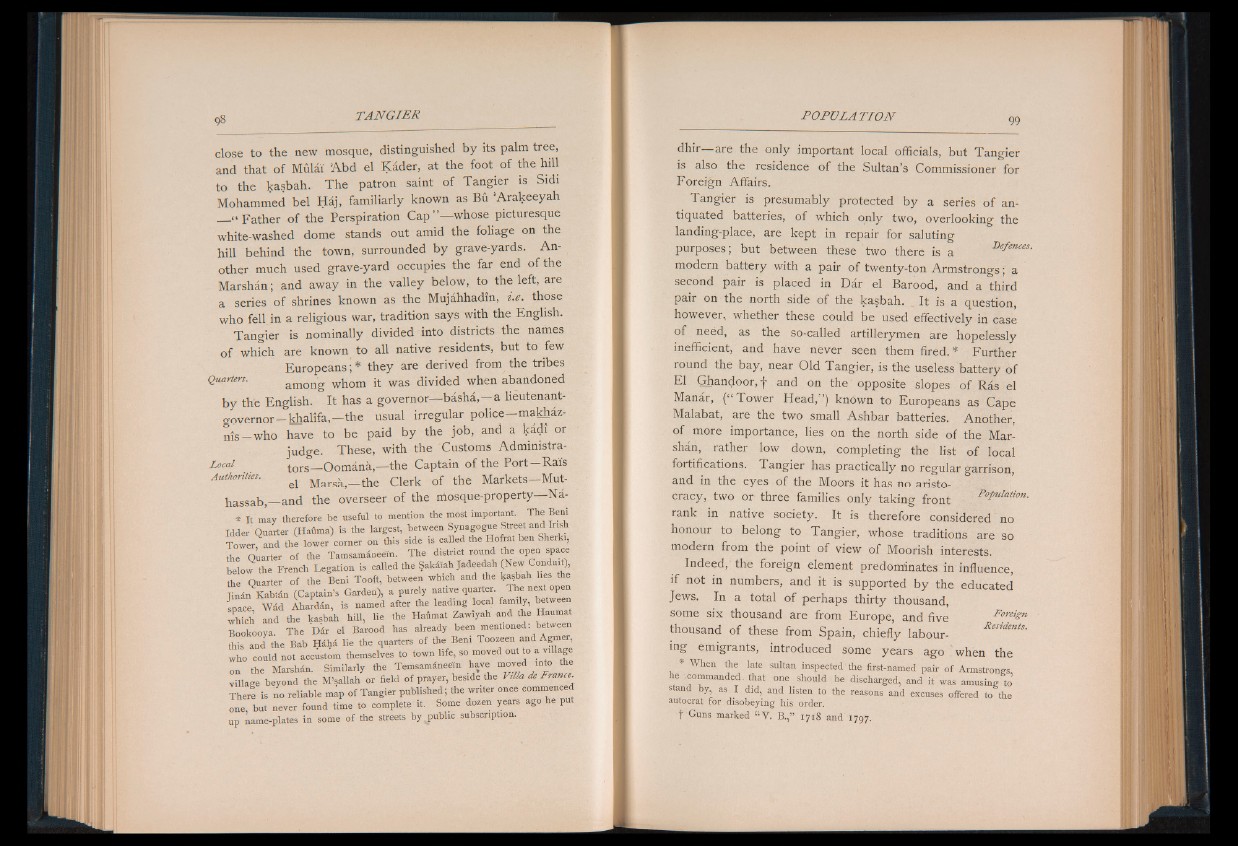
close to the new mosque, distinguished by its palm tree,
and that of Mulai Abd el Kader, at the foot of the hill
to the kasbah. The patron saint of Tangier is Sidi
Mohammed bel Haj, familiarly known as Bu Arakeeyah
“ Father of the Perspiration C ap ”— whose picturesque
white-washed dome stands out amid the foliage on the
hill behind the town, surrounded by grave-yards. Another
much used grave-yard occupies the far end of the
Marshan; and away in the valley below, to the left, are
a series of shrines known as the Mujahhadin, i.e. those
who fell, in a religious war, tradition says with the English.
Tangier is nominally divided into districts the names
of which are known to all native residents, but to few
Europeans; * they are derived from the tribes
Quarters. among whom it was divided when abandoned
by the English. It has a governor— basha,||a lieutenant-
governor— khalifa,— the usual irregular police— makhaz-
n is -w h o have to be paid by the job, and a lja<p or
judge. These, with the Customs Administra-
Local tors— Oomana,— the Captain of the Port—Rais
Authorities. ^ Margk _ the c le rk of the Markets-Muthassab,
and the overseer of the mosque-property Na-
* It may therefore be useful to mention the most important. The Beni
Idder Quarter (Hauma) is the largest, between Synagogue Street and Irish
Tower, and the lower corner on this side is called the Hofrat ben Sherki,
the Ouarter of the Tamsamineein. The district round the open space
below the French Legation is called the Sakaiah Jadeedah
the Quarter of the Beni Tooft, between which and the kasbah lies the
Jinan Kabtan (Captain’s Garden), a purely native quarter. The next open
space Wad AhardSn, is named after the leading local family, between
which and the kasbah hill, lie the Haumat Zawiyah and the Hauma
Bookooya. The D4r el Barood has already been mentioned, between
this and the Bab Haha lie the quarters of the Beni Toozeen and Agme ,
who could not accustom themselves to town life, so moved out to a village
on the Marshan. Similarly the Temsamaneem have moved into the
village beyond the M’sallah or field of prayer, beside the Villa de France.
There is no reliable map of Tangier published; the writer once commenced
one but never found time to complete it. Some dozen years ago he put
up name-plates in some of the streets by jmblic subscription.
dhir— are the only important local officials, but Tangier
is also the residence of the Sultan’s Commissioner for
Foreign Affairs.
Tangier is presumably protected by a series o f antiquated
batteries, of which only two, overlooking the
landing-place, are kept in repair for saluting
purposes; but between these two there is a W^ces.
modern battery with a pair of twenty-ton Armstrongs; a
second pair is placed in Dar el Barood, and a third
pair on the north side of the kasbah. .. It is a question,
however, whether these could be used effectively in case
of need, as the so-called artillerymen are hopelessly
inefficient, and have never seen them fired.* Further
round the bay, near Old Tangier, is the useless battery of
El Ghandoor, j- and on the opposite slopes of Ras el
Manar, (“ Tower Head,” ) known to Europeans as Cape
Malabat, are the two small Ashbar batteries. Another,
of more importance, lies on the north side of the Marshan,
rather low down, completing the list o f local
fortifications. Tangier has practically no regular garrison,
and in the eyes of the Moors it has no aristocracy,
two or three families only taking front Population.
rank in native society. It is therefore considered no
honour to belong to Tangier, whose traditions are so
modern from the point of view of Moorish interests.
Indeed, the foreign element predominates in influence,
if not in numbers, and it is supported by the educated
Jews. In a total of perhaps thirty thousand,
some six thousand are from Europe, and five Foreign
thousand of these from Spain, chiefly labour- Residentsing
emigrants, introduced some years ago when the
4 When the late sultan inspected the first-named pair of Armstrongs
he .commanded, that one should be discharged, and it was amusing to
s and by, as I did, and listen to the reasons and excuses offered to the
autocrat for disobeying his order.
t Guns marked “ V. B.,” 1718 and 1797.